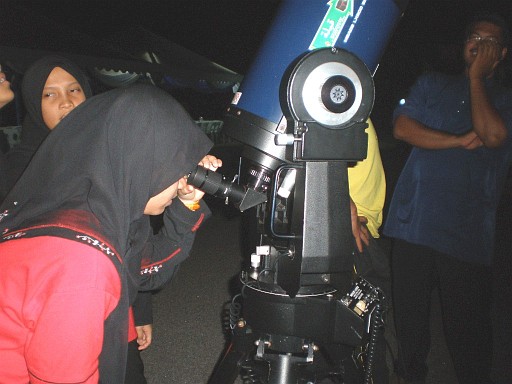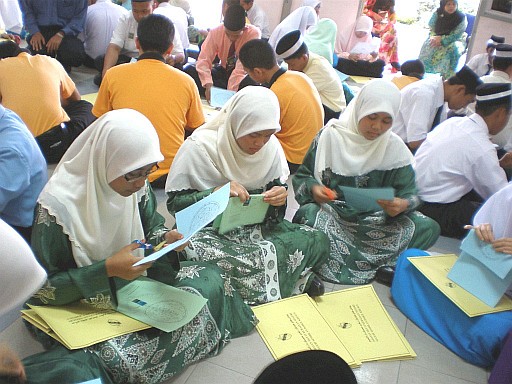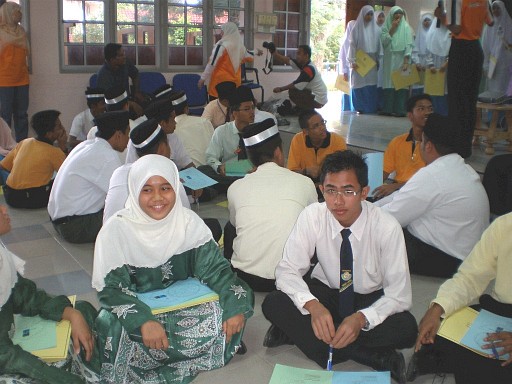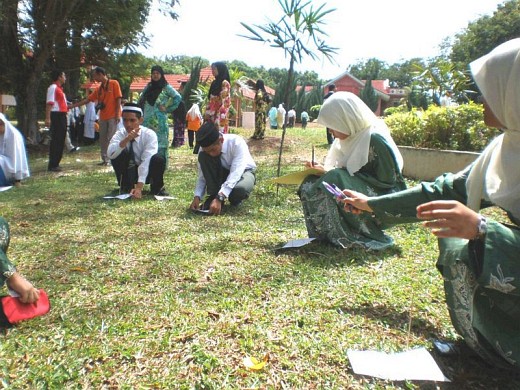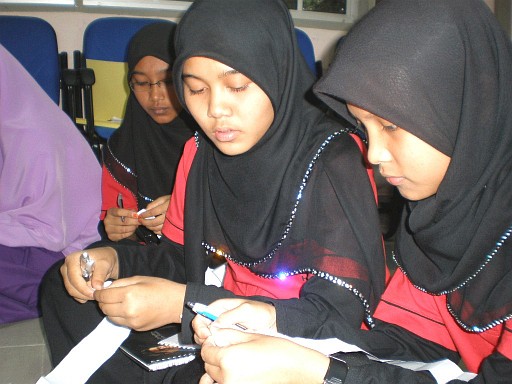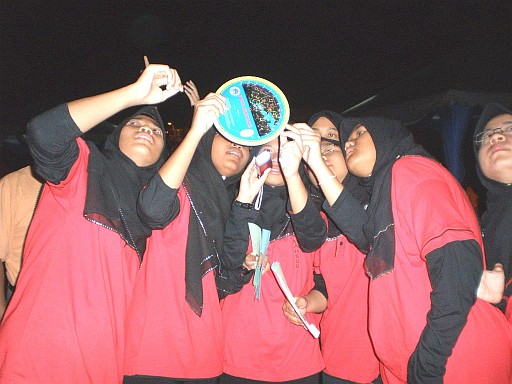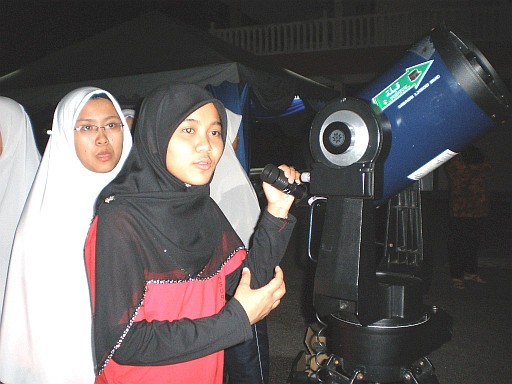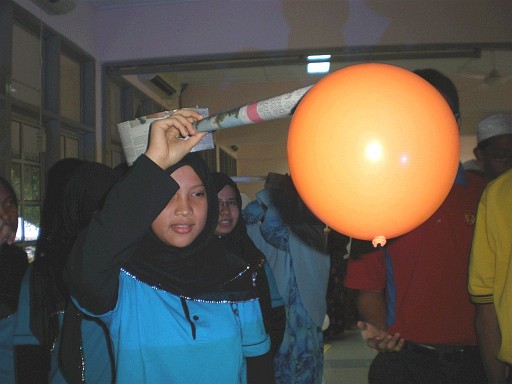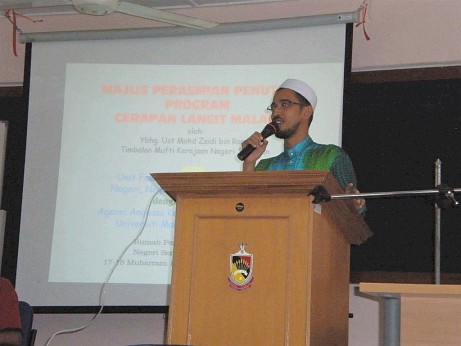Malaysia - TUNKU KURSHIAH COLLEGE (TKC) /UNESCO CLUB
We were told by Mr. Ridzuan that Malaysia is located at the Tropical climate and this type of climate gets both of the sky. This makes Malaysia a special country in the world..
The Programme
NIGHT SKY OBSERVATION
DATE 14TH JANUARY - 15TH JANUARY 2009
VENUE NEGERI SEMBILAN GOVERNMENT REST HOUSE, PORT DICKSON, NEGERI SEMBILAN
PARTICIPANTS 10 REPRESENTATIVES FROM TUNKU KURSHIAH COLLEGE AND OTHER REPRESENTATIVES FROM 12 SCHOOLS IN NEGERI SEMBILAN
INTRODUCTION
On 14th and 15th January 2009, ten students of Al-Falak Young Scientists, UNESCO Club from Tunku Kurshiah College participated in the night sky observation programme. This programme was organised by the Astronomy Unit of the state's Mufti Department (Negeri Sembilan) with the help of National Agency of Astronomy at Port Dickson, one of the town in Negeri Sembilan. Participants came from various schools in Negeri Sembilan.
VENUE: GOVERNMENT REST HOUSE, PORT DICKSON, NEGERI SEMBILAN, MALAYSIA
REGISTRATION We registered at 9 a.m. and we were given a room for five persons according to the schools. After that, we were divided into groups and the activities started at 11 a.m.
ACTIVITIES
These are the activities that had been planned for the whole programme.
PLANISPHERE
TRIGONOMETRY
TELESCOPE
THE DISTANCE OF THE PLANETS FROM THE SUN
NIGHT SKY OBSERVING ACTIVITY
EXPERIMENT ABOUT ECLIPSE
BRIEFING ABOUT HISTORY OF SPACE EXPLORATION
FALAK ONLINE
CLOSING CEREMONY
DATE 14TH JANUARY - 15TH JANUARY 2009
VENUE NEGERI SEMBILAN GOVERNMENT REST HOUSE, PORT DICKSON, NEGERI SEMBILAN
PARTICIPANTS 10 REPRESENTATIVES FROM TUNKU KURSHIAH COLLEGE AND OTHER REPRESENTATIVES FROM 12 SCHOOLS IN NEGERI SEMBILAN
INTRODUCTION
On 14th and 15th January 2009, ten students of Al-Falak Young Scientists, UNESCO Club from Tunku Kurshiah College participated in the night sky observation programme. This programme was organised by the Astronomy Unit of the state's Mufti Department (Negeri Sembilan) with the help of National Agency of Astronomy at Port Dickson, one of the town in Negeri Sembilan. Participants came from various schools in Negeri Sembilan.
VENUE: GOVERNMENT REST HOUSE, PORT DICKSON, NEGERI SEMBILAN, MALAYSIA
REGISTRATION We registered at 9 a.m. and we were given a room for five persons according to the schools. After that, we were divided into groups and the activities started at 11 a.m.
ACTIVITIES
These are the activities that had been planned for the whole programme.
PLANISPHERE
TRIGONOMETRY
TELESCOPE
THE DISTANCE OF THE PLANETS FROM THE SUN
NIGHT SKY OBSERVING ACTIVITY
EXPERIMENT ABOUT ECLIPSE
BRIEFING ABOUT HISTORY OF SPACE EXPLORATION
FALAK ONLINE
CLOSING CEREMONY
PLANISPHERE
The first activity for this programme was planisphere.
Our lecturer, Mr. Ridzuan from National Agency of Astronomy gave us two pieces of planisphere. But the planisphere was not completed and we had to cut it ourselves. After that we combined it.
Planisphere means the star map. The planisphere is used to identify the position of the constellations. We were given the north and south sky planisphere. When we first saw it, we didn't know how to use it, but our teacher tought us how to use planisphere.
We were told by Mr. Ridzuan that Malaysia is located at the Tropical climate and this type of climate gets both of the sky. This makes Malaysia a special country in the world.
Besides that, we can also downloaded the planisphere in our handphone to see the constellations easier wherever we are. To download the planisphere programe, we have to search the internet using the key word ‘Sideralis'. The constellations can be observed by entering the date, time, and name of the country we live in. Mr. Ridzuan told us that there are 88 constellations. But only 12 of them are well-known by the people, which are the name of the horoscopes.
Our lecturer, Mr. Ridzuan from National Agency of Astronomy gave us two pieces of planisphere. But the planisphere was not completed and we had to cut it ourselves. After that we combined it.
Planisphere means the star map. The planisphere is used to identify the position of the constellations. We were given the north and south sky planisphere. When we first saw it, we didn't know how to use it, but our teacher tought us how to use planisphere.
We were told by Mr. Ridzuan that Malaysia is located at the Tropical climate and this type of climate gets both of the sky. This makes Malaysia a special country in the world.
Besides that, we can also downloaded the planisphere in our handphone to see the constellations easier wherever we are. To download the planisphere programe, we have to search the internet using the key word ‘Sideralis'. The constellations can be observed by entering the date, time, and name of the country we live in. Mr. Ridzuan told us that there are 88 constellations. But only 12 of them are well-known by the people, which are the name of the horoscopes.
TRIGONOMETRY
Next, we were taught how to count the distance of the Earth from the stars. We used the concept of trigonometry to count it so that it will be easier for us to know the distance. Moreover, we apply this concept when we are given a situation and problems to solve. We had to calculate the distance of eight points which form a big hexagon that have been plotted using sticks and scale papers. This activity was carried out at the field.
After finished, we were required to go to the hall for the next activity. We were given a piece of paper to redraw the hexagon that we had calculated with the real scale. We learnt good teamwork; even though we were from the different schools, we could cooperate with each other to solve the problem together.
After finished, we were required to go to the hall for the next activity. We were given a piece of paper to redraw the hexagon that we had calculated with the real scale. We learnt good teamwork; even though we were from the different schools, we could cooperate with each other to solve the problem together.
TELESCOPE
At 2.30 p.m., we were given a group work on telescope. We have to do a group presentation. Each group was given a ‘mahjong’ paper and two markers which were blue and red markers. Before we started our group work, we were given 10 minutes to think about what we already knew about telescopes. Then, we started our work. Actually, we had to do a ‘brain storming’. To just write anything about telescopes that crossed our minds. In this session, blue markers were used and we were given 10 minutes to do it. Then, we had to do a presentation for all the teachers and students. What we had already known about telescope was little, only a few bits of information on telescopes.
After that, we were exposed to what telescope is by Mr. Ridzuan through a slide show presentation. We were given 10 more minutes to add information to our ‘mahjong' paper with red markers. Next, we presented it again. We got a lot of information from this activity. We took the opportunity to ask Mr. Ridzuan for more information. The activity ended at about 4.00 p.m. Then, we took tea together and were given time to rest and pray before the next activities at night.
After that, we were exposed to what telescope is by Mr. Ridzuan through a slide show presentation. We were given 10 more minutes to add information to our ‘mahjong' paper with red markers. Next, we presented it again. We got a lot of information from this activity. We took the opportunity to ask Mr. Ridzuan for more information. The activity ended at about 4.00 p.m. Then, we took tea together and were given time to rest and pray before the next activities at night.
DISTANCE OF THE PLANETS FROM THE SUN
This activity started at 4 o'clock in the evening. We were asked to divide the ‘mahjong' paper equally among our group members. Next, everyone needed to fold their own paper into two and place a planet named Saturn in the middle and the Sun and Neptune at the end of the paper. After that, we folded the paper again into four sections. We drew a planet named Uranus between Saturn and Neptune. We folded the paper into eight more sections so we can place a planet named Jupiter and the Asteroid Belt between the Sun and Saturn. We took one eighth of the paper and folded it into two to calculate the distance of Venus from the Sun. We folded the paper into two again to find the distance of Mercury and Mars from the Sun. Lastly, we folded the paper into 64 parts and named planet Earth at the fifth section.
From this activity, we learnt that teamwork among our own group was very important.
Many participants got confused when folding the paper because this activity was a bit complicated and needed a lot of patience. But each group showed their own burning desire to find the distance of planets from the Sun.
This activity had taught us that our Milky Way solar system is too big and wide. Lastly, everyone enjoyed doing this activity because it was interesting and tested our minds to find the distance of each and every planet from the Sun, but not including planet Pluto because it is too small and it is very hard to even when you use the telescope.
From this activity, we learnt that teamwork among our own group was very important.
Many participants got confused when folding the paper because this activity was a bit complicated and needed a lot of patience. But each group showed their own burning desire to find the distance of planets from the Sun.
This activity had taught us that our Milky Way solar system is too big and wide. Lastly, everyone enjoyed doing this activity because it was interesting and tested our minds to find the distance of each and every planet from the Sun, but not including planet Pluto because it is too small and it is very hard to even when you use the telescope.
NIGHT SKY OBSERVING ACTIVITY
The next activity was the Night Sky Observation. The event took place at the parking area of the Negeri Sembilan Rest House, Port Dickson, Negeri Sembilan. There were about eight telescopes provided. We were guided by the people from National Agency of Astronomy.
At about 8.45 p.m., we saw a planet called Venus. That night, we observed so many types of constellation. The most popular constellation is Orion. A professor from University Malaya was also there. He gave a talk on the brightest star named Sirius.
At about 10.00 p.m., we rested for a while and took supper. We continued the activity at about 10.15 p.m. and waited for the Moon to rise. Luckily, after waiting for a very long time, the Moon finally appeared at 11.45 p.m. We were told by the professor that below the Moon, we could see a planet called Saturn. We cannot see the Saturn (the most beautiful planet) clearly, because it is located too far from the Earth. At 12.30 a.m., we went back to our room.
At about 8.45 p.m., we saw a planet called Venus. That night, we observed so many types of constellation. The most popular constellation is Orion. A professor from University Malaya was also there. He gave a talk on the brightest star named Sirius.
At about 10.00 p.m., we rested for a while and took supper. We continued the activity at about 10.15 p.m. and waited for the Moon to rise. Luckily, after waiting for a very long time, the Moon finally appeared at 11.45 p.m. We were told by the professor that below the Moon, we could see a planet called Saturn. We cannot see the Saturn (the most beautiful planet) clearly, because it is located too far from the Earth. At 12.30 a.m., we went back to our room.
EXPERIMENT ABOUT ECLIPSE
On 15th January 2009, after having enough rest, we started our activities with a little talk on eclipse by Mr. Ridzuan. Then, we were told to conduct an experiment about the eclipse. We were given scissors, balloon, newspapers, cellophane tape and blades, to start our first project. At first, we thought that this experiment was difficult. But, with the cooperation given by our group mates and the good communication between us and our instructor, we found this experiment quite easy. These were the steps.
1. We had to take about 3 pieces of newspapers and then stick them together. Then, we had to shape the newspapers into a circle.
2. After that, we can make a long rod by using other newspapers.
3. Next, we had to join the rod with the newspapers that had been shaped into a circle.
4. Finally, we had to stick the balloon at the end of the rod. In order to see the eclipse, we had to test it in front of the projector.
By doing this experiment, we could see the eclipse in front of our eyes. To tell the truth, this experiment was really exciting and interesting.THE HISTORY OF SPACE EXPLORATION
On the last day, we had been briefed about the history of space exploration. The talk was delivered by Mr. Ridzuan. That talk started at 8.30 a.m.
These are parts of the question that being asked.
Why people want to go to space? The factors are military, curiosity, science, predicting the future, understanding our own world and finding other life forms. The Military must use high technology to go there.
How rockets came to be? Rocket is a large bullet which carries nuclear warheads to any place in the world. The first rocket recorded was a concept and invention by the Nazi in Germany.
Do you know Sputnik 1? Sputnik 1 is the first satellite launched into space by the Soviet Union from Russian. The satellite was launched on 4th October 1957.This satellite is use to transmit Morse code. Morse code is one of the first communication modes.
When was the first test flight? First test flight includes a live test subject - a dog named Laika. This flight launched into orbit on Nov, 3 1957. She died cause of the overheating of the spacecraft as it was never designed to come back safely to earth.
What is the United State's Apollo Programme? This programme started in 1961 until 1975 which has three types of rockets, Apollo 11, Apollo 13 and Apollo 15. The mission was to send people to the moon. Apollo 11 is the first rocket that arrived on the moon. They sent Neil Armstrong and Buzz Aldrin. Apollo 13 was sent for lunar landing. The part of the space craft had exploded.
These are parts of the question that being asked.
Why people want to go to space? The factors are military, curiosity, science, predicting the future, understanding our own world and finding other life forms. The Military must use high technology to go there.
How rockets came to be? Rocket is a large bullet which carries nuclear warheads to any place in the world. The first rocket recorded was a concept and invention by the Nazi in Germany.
Do you know Sputnik 1? Sputnik 1 is the first satellite launched into space by the Soviet Union from Russian. The satellite was launched on 4th October 1957.This satellite is use to transmit Morse code. Morse code is one of the first communication modes.
When was the first test flight? First test flight includes a live test subject - a dog named Laika. This flight launched into orbit on Nov, 3 1957. She died cause of the overheating of the spacecraft as it was never designed to come back safely to earth.
What is the United State's Apollo Programme? This programme started in 1961 until 1975 which has three types of rockets, Apollo 11, Apollo 13 and Apollo 15. The mission was to send people to the moon. Apollo 11 is the first rocket that arrived on the moon. They sent Neil Armstrong and Buzz Aldrin. Apollo 13 was sent for lunar landing. The part of the space craft had exploded.
FALAK ONLINE
This was our last activity throughout the course. This activity was mainly a talk session and an introduction to the Falak Online website. Falak Online features what transcends beyond the science text book. To those who are curious and about what makes up the beautiful sky, then this website is the ultimate solution to quench the thirst. Apart from the distance between the earth and the sun and also how many clusters of stars are there in the sky, visitors to this website can actually dictate the date and time to observe the sky of one particular place. This activity was very interesting but unfortunately, we did not manage to try our hands on the website due to time constraints. Besides that, we were exposed to something we observe every night which are the stars. In short, this final programme was a conclusion to everything that we had experienced the day before.
CLOSING CEREMONY
The programme was ended at about 12.30 pm, with a speech from Mr. Zaidi Ramli. He expressed his appreciation for the people who were involved in this programme and handed us a certificate for our participation.
CONCLUSION
Basically, this was our new experience because we never involve in this kind of programme before. From this programme, we learnt more knowledge about space exploration. We learnt the various types of telescopes. The activities were very fun because it was an experience where we had the chance to see the planets, stars and moon closer. We were very excited and felt very lucky to participate in this programme. We intend to share all the experience with all our schoolmates. In a nutshell, learning the wonders of science and noble values are part and parcel of molding tomorrow’s leaders which are capable in science and technology plus we were able to interact with all walks of people. This experience really taught us about noble values such as appreciation, teamwork and creativity. We also get the chance to observe the magnificent creation of God.
SPECIAL THANKS We also want to express our appreciation to our principal, Mrs. Che Kamaliah Endud who gave a lot of support and encouraged us to join this programme.
To Mr. Najmi Md Ghazali, thanks for everything.
Ali Osman
SPECIAL THANKS We also want to express our appreciation to our principal, Mrs. Che Kamaliah Endud who gave a lot of support and encouraged us to join this programme.
To Mr. Najmi Md Ghazali, thanks for everything.
Ali Osman
